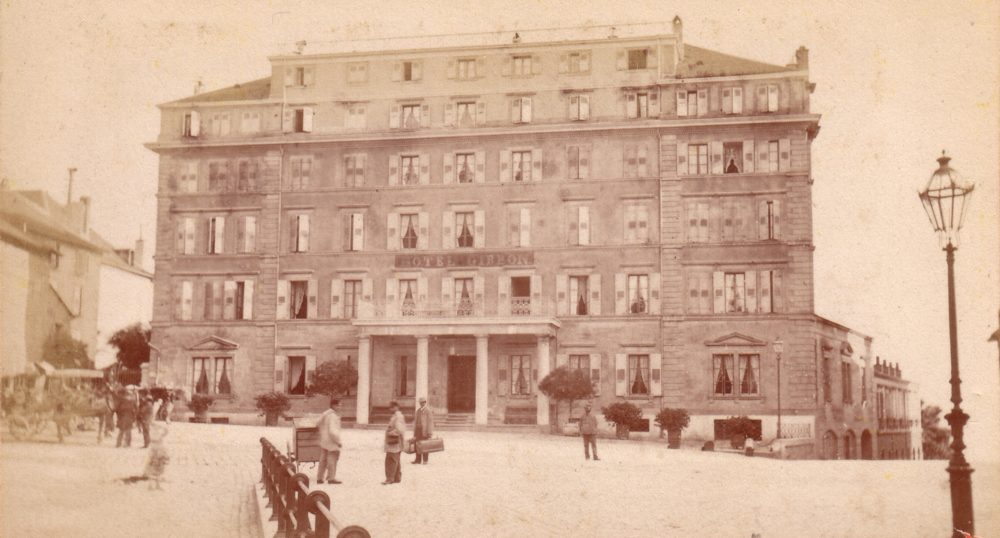
Hotel Gibbon (1839-1920), Lausanne
“After laying down my pen I took several turns in a berceau, or covered walk of acacias, which commands a prospect of the country, the lake, and the mountains. The air was temperate, the sky was serene, the silver orb of the moon was reflected from the waters, and all nature was silent. I will not dissemble the first emotions of joy on recovery of my freedom, and, perhaps, the establishment of my fame. But my pride was soon humbled, and a sober melancholy was spread over my mind, by the idea that I had taken an everlasting leave of an old and agreeable companion. . . .”
That’s how Edward Gibbon describes finishing his big book in Lausanne in 1793, The History of the Decline and Fall of the Roman Empire. He had been working on it for ten years, and in 1794 he died. In six volumes, it does what it says on the packet. ‘It was fine until the barbarians came,’ might be his argument for how things fell apart for the Romans. That thesis still seems to be in the air and empires that have come and gone since the Romans have made ample use of the barbarians at the gates.
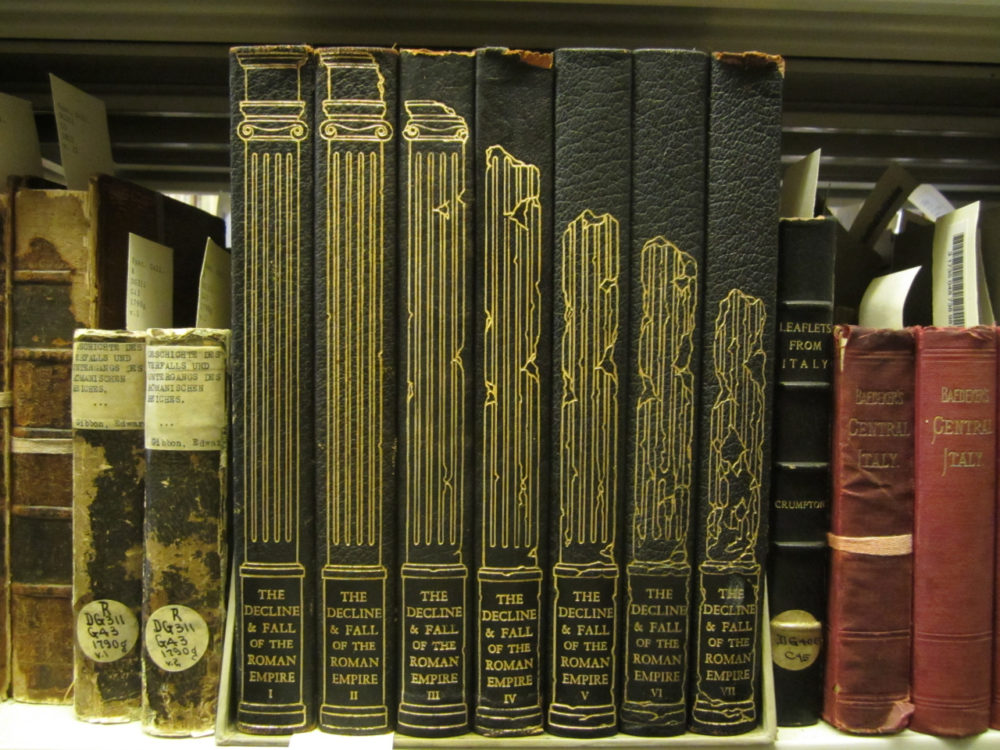
A Limited Editions Club set of Gibbon’s classic, with arresting spine design created by Clarence P. Hornung.
I have to confess I haven’t read Gibbon’s big book. It’s on a bucket list. But I’ve been re-reading Thomas Hardy, who visited Lausanne in June 1897 and stayed at the Hotel Gibbon, like many literary pilgrims before him. The hotel, demolished in 1920, was built on the site of Gibbon’s old house and sloping garden with its acacia trees. Hardy walked in the garden in the evening and realised it was a hundred and ten years to the day, to the hour, since Gibbon’s walk the night he finished his magnum opus. This sparked a fine poem about achievement and truth – “How fares the truth now? – Ill?” The question, of course, remains vexed in our own time. Here’s the poem in its entirety:
Lausanne, In Gibbon’s Old Garden: 11-12 p.m.
by Thomas Hardy
(The 110th anniversary of the completion of the “Decline and Fall” at the same hour and place)
A spirit seems to pass,
Formal in pose, but grave and grand withal:
He contemplates a volume stout and tall,
And far lamps fleck him through the thin acacias.Anon the book is closed,
With “It is finished!” And at the alley’s end
He turns, and soon on me his glances bend;
And, as from earth, comes speech–small, muted, yet composed.“How fares the Truth now?–Ill?
–Do pens but slily further her advance?
May one not speed her but in phrase askance?
Do scribes aver the Comic to be Reverend still?“Still rule those minds on earth
At whom sage Milton’s wormwood words were hurled:
‘Truth like a bastard comes into the world
Never without ill-fame to him who gives her birth’?”
It’s an intimate conversation between Hardy and Gibbon about truth speaking to power, with Milton entering stage right holding a thunderbolt: “Truth like a bastard comes into the world…”. By 1897 Hardy had completed his novels Tess of the d’Urbervilles and Jude the Obscure and taken flak defending the bastards. Gibbon had let fly at all three monotheistic religions and been hauled up in the court of opinion. Milton, the creator of God and Satan, by any measure larger-than-life characters, knew a thing or two about speaking truth to power. Fake news mewling from the White House gets drowned out in such company. Hardy seems to be saying that “from earth, comes speech – small, muted, yet composed.”
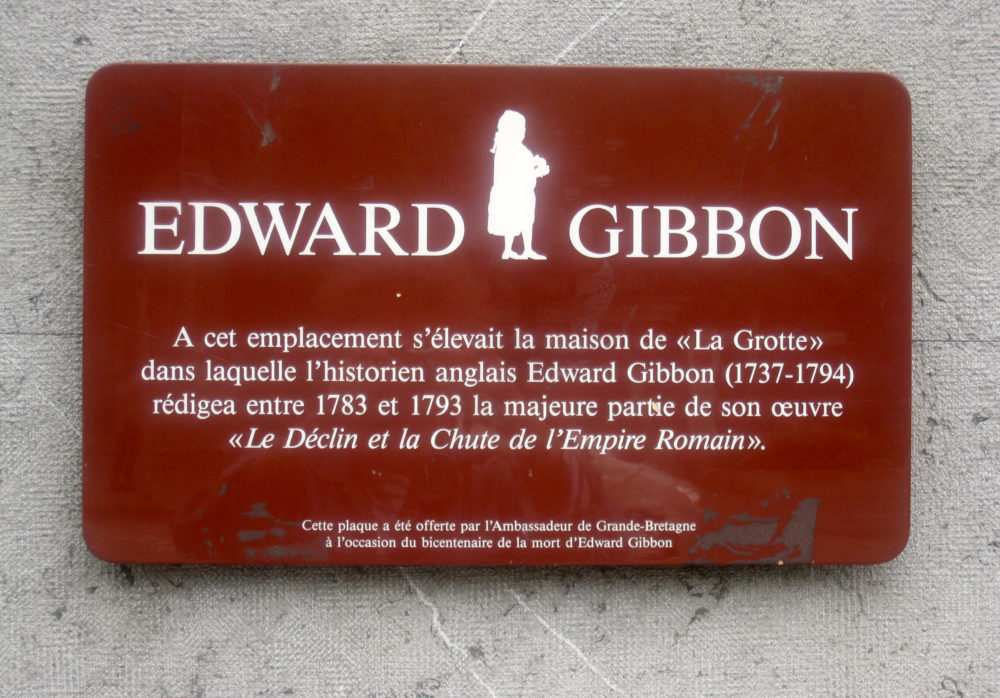
Plaque at the former location of Edward Gibbon’s house in Lausanne
It was an accident of education that brought Gibbon to Lausanne. After a fraught year at Magdalen College, Oxford, the sixteen year-old convert to Catholicism was sent to lodge with Daniel Pavillard, a Reformed minister in Lausanne, who was supposed to sort him out. Daddy threatened to cut him off without pocket money if he didn’t leave the Scarlet Woman of Rome. Gibbon spent five formative years in Switzerland. A second stay in Lausanne many years later, from September 1783 to August 1787, sealed his connection to the city. His old friend from teenage years, Jacques Georges Deyverdun, the French translator of Goethe, died in 1789, and willed Gibbon his home in Lausanne, La Grotte, demolished in 1896.
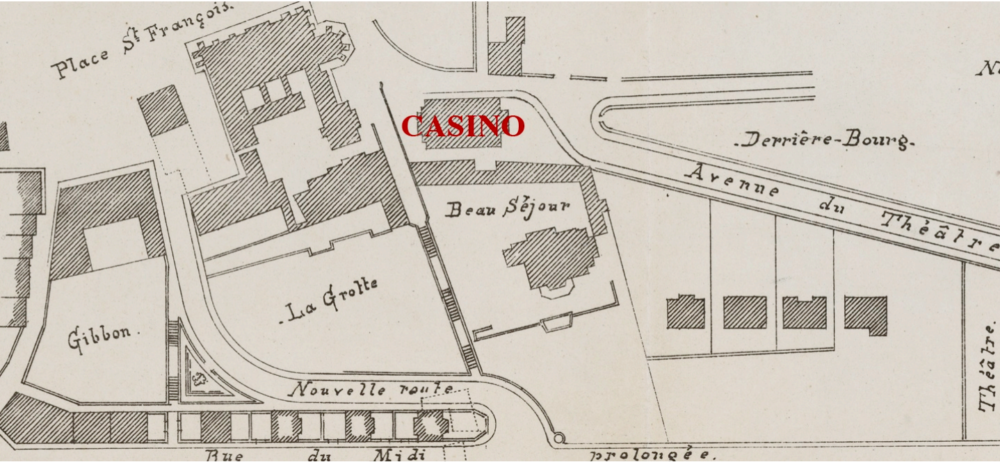
Ground plan of the location of the Maison de la Grotte in relation to the Gibbon Hotel.
Charles Dickens spent six months in Lausanne in 1846, working on a Christmas book and on the early chapters of his novel Dombey and Son. “I never saw so many booksellers’ shops crammed within the same space, as in the steep up-and-down streets of Lausanne,” he wrote his friend and biographer John Forster. He stayed a couple of days at the Gibbon Hotel with his wife, his children, four maids and a dog.

Rosemont, where Dickens stayed for six months in Lausanne.
Dickens considered renting the Villa l’Elysée where today there is a photography museum. But he opted for a smallish house called Rosemont for ten pounds a month. “It is beautifully situated on the hill that rises from the lake, within ten minutes walk of this hotel, and furnished, though scantily as all here are, better than others … my little study is upstairs, and looks out, from two French windows opening into a balcony, on the lake and mountains…” At the end of a month he had the first four chapters of Dombey and Son ready to show.
The Villa Rosemont as it was in Dickens’ day is no longer standing but a pink stucco building on the corner of Avenue Charles-Dickens and Avenue Auguste-Tissot appears to be where it was located. It may have been a girls’ school for a while during the last couple of decades of the nineteenth century, reminiscent of Muriel Spark’s Finishing School, also set in the area.

Perhaps the fate of Dickens’ Rosemont in Lausanne: French, the ‘ornamental arts’, lawn tennis, a spot of gym and a cold shower.
Dickens was a walker, regularly going out along the vineyard paths towards Lavaux for his evening constitutional. In a later novel, Little Dorrit, he moves the narrative to an ascent of the St. Bernard Pass. In a letter to his biographer John Forster he describes the pass:
I wish to God you could see that place. A great hollow on the top of a range of dreadful mountains, fenced in by riven rocks of every shape and colour: and in the midst, a black lake, with phantom clouds perpetually stalking over it. Peaks, and points, and plains of eternal ice and snow, bounding the view, and shutting out the world on every side: the lake reflecting nothing: and no human figure in the scene.
Dickens goes on to describe the mortuary of the hospice, which had been functioning on the pass since the fifteenth century:
The mortuary was an outhouse beside the convent full of those who crossing the pass, the unclaimed presented as they were found in the snow. They were not laid down, or stretched out, but standing up, in corners and against walls; some erect and horribly human, with distinct expressions on the faces; some sunk down on their knees; some dropping over on one side; some tumbled down altogether, and presenting a heap of skulls and fibrous dust. There is no other decay in that atmosphere; and there they remain during the short days and the long nights, the only human company out of doors, withering away by grains, and holding ghastly possession of the mountain where they died.
From Paris, in November 1846, Dickens had this to say about the Swiss: “Don’t be hard upon the Swiss. They are a thorn in the sides of European despots, and a good wholesome people to live near Jesuit-ridden kings on the brighter side of the mountains. My hat shall ever be ready to be thrown up, and my glove ever ready to be thrown down for Switzerland.”

Hotel Gibbon, lithograph from 1860, giving an idea of the splendid terraced gardens from the Place St. François down to the lake, with Maison La Grotte visible on the immediate right.

Left, La Maison de la Grotte where Gibbon lived, right the Convent of St. Francois, photo 1894.
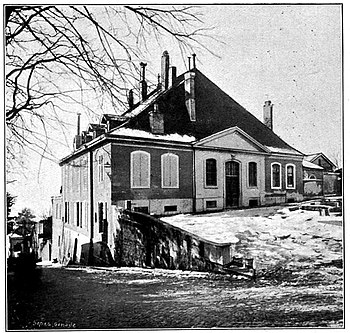
La Grotte, formerly the Deyverdun home, where Gibbon lived from 1783 to 1793 (demolished 1896).


2 thoughts on “Gibbon’s Old Garden in Lausanne”